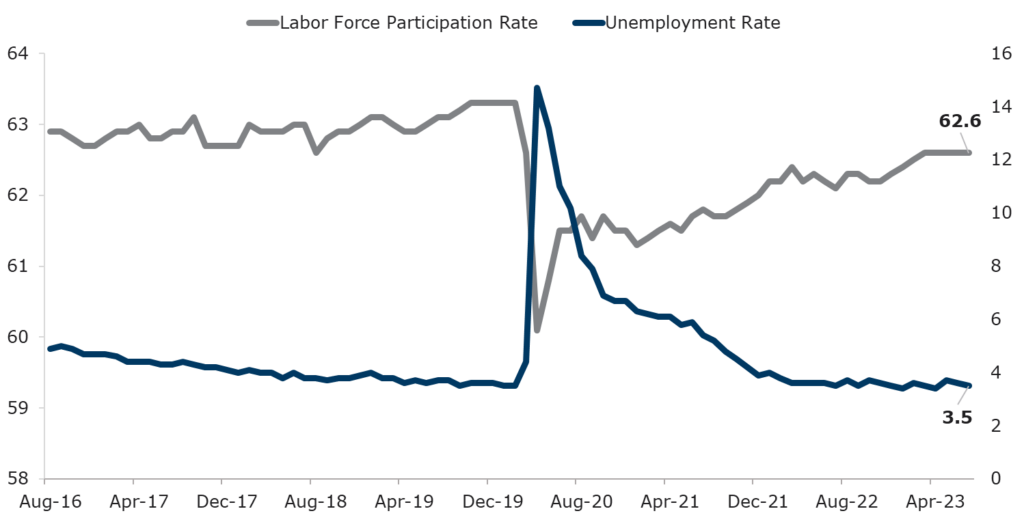
August 2023 Economic Review
With measures of inflation remaining stubbornly above its 2% target, the Federal Open Market Committee (FOMC) continued its fight against inflation with another rate hike at its July meeting. As widely anticipated, the FOMC raised its target policy rate range up 25 basis points to a new target range of 5.25% to 5.50%, the highest level in 22 years. This marks the 11th rate increase since the FOMC started its most aggressive campaign against inflation since the 1980’s.
So far, such restrictive policy measures have not been able to drag the economy into a recession. Both consumer and business spending have been resilient. The labor market remains tight, with nonfarm payrolls sufficiently solid and unemployment at multidecade lows. Headline measures of inflation have shown signs of cooling with the Consumer Price Index down to 3.2% in July of 2023, far below its peak of 9.1% in June of 2022. Non-headline measures such as the Core Personal Consumption Expenditure Index are off their peaks as well.
Against this backdrop, there is growing support for the prospect of the FOMC engineering a soft landing and avoiding a recession altogether. Economists at the Federal Reserve and a growing number on Wall Street have dropped their forecasts for an upcoming recession. Results from a recent survey by the National Association for Business Economics echo this sentiment with roughly 71% of business economists surveyed having odds of recession in the next 12 months as 50% or lower.
The FOMC will certainly face headwinds on the path towards a soft landing. As monetary policy operates with long and variable lags, the full impact of the most recent cycle of rate hikes may yet to be seen. Maintaining rates at an elevated level for a prolonged period of time will further weigh on credit conditions and amplify restrictive policy measures. Furthermore, continued resilience in spending and the labor market may derail the FOMC’s efforts to curb inflation and even warrant additional tightening.
On the fiscal front, further challenges await. Fitch Ratings’ recent downgrade of US government debt from AAA to AA+ serves as a timely reminder. In its ratings decision, Fitch highlights concerns over high and growing budget deficits, increasing interest service costs, rising mandatory spending, and the “erosion of governance” that has led to recurring rounds of political theater over the debt ceiling.
While expectations for a soft landing may be increasing given the recent resilience demonstrated by the economy, much uncertainty remains and the evolution and quality of further data will be a key driver for monetary policy going forward.

Current Economic Releases |
|||
| Data | Period | Value | |
| GDP QoQ | Q2 ’23 | 2.40% | |
| US Unemployment | Jul ’23 | 3.50% | |
| ISM Manufacturing | Jul ’23 | 46.4 | |
| PPI YoY | Jul ’23 | 0.80% | |
| CPI YoY | Jul ’23 | 3.20% | |
| Fed Funds Target | Aug 23, 2023 | 5.25% – 5.50% | |
Treasury Yields |
|||
| Maturity | 8/23/23 | 7/24/23 | CHANGE |
| 3-Month | 5.291% | 5.411% | -0.119% |
| 6-Month | 5.489% | 5.476% | 0.013% |
| 1-Year | 5.362% | 5.344% | 0.018% |
| 2-Year | 4.967% | 4.919% | 0.048% |
| 3-Year | 4.656% | 4.511% | 0.145% |
| 5-Year | 4.370% | 4.152% | 0.218% |
| 10-Year | 4.192% | 3.873% | 0.319% |
| 30-Year | 4.270% | 3.922% | 0.348% |
Agency Yields |
|||
| Maturity | 8/23/23 | 7/24/23 | CHANGE |
| 3-Month | 5.499% | 5.532% | -0.033% |
| 6-Month | 5.513% | 5.508% | 0.006% |
| 1-Year | 5.428% | 5.412% | 0.016% |
| 2-Year | 4.999% | 4.949% | 0.050% |
| 3-Year | 4.714% | 4.602% | 0.112% |
| 5-Year | 4.446% | 4.246% | 0.200% |
Source: Bloomberg. Data as of August 23, 2023. Data unaudited. Many factors affect performance including changes in market conditions and interest rates and in response to other economic, political, or financial developments. Investment involves risk including the possible loss of principal. No assurance can be given that the performance objectives of a given strategy will be achieved. All comments and discussions presented are purely based on opinion and assumptions, not fact. These assumptions may or may not be correct based on foreseen and unforeseen events. The information presented should not be used in making any investment decisions. This material is not a recommendation to buy, sell, implement, or change any securities or investment strategy, function, or process. Any financial and/or investment decision should be made only after considerable research, consideration, and involvement with an experienced professional engaged for the specific purpose. Past performance is not an indication of future performance. Any financial and/or investment decision may incur losses.
